Trophy Hunting
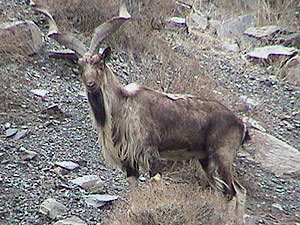 There are many reasons why people hunt. For a villager in a remote mountain community, the hunt may be done out of economic necessity, while an international trophy hunter may leave the comforts of his home and seek the solitude of a far away mountain side, risking life and limb in pursuit of a much sought after head. Generally, it is assumed that hunting will eliminate a threatened animal species. This would have been true before the introduction of trophy hunting, when villagers hunted for food and not for sport. In modern trophy hunting , large sums of money are paid by intending hunters as trophy fee, which largely go to the communities. Thus the communities see the economic value of wild life and desist from unnecessary killing of game animals and protect them on a sustainable basis.
There are many reasons why people hunt. For a villager in a remote mountain community, the hunt may be done out of economic necessity, while an international trophy hunter may leave the comforts of his home and seek the solitude of a far away mountain side, risking life and limb in pursuit of a much sought after head. Generally, it is assumed that hunting will eliminate a threatened animal species. This would have been true before the introduction of trophy hunting, when villagers hunted for food and not for sport. In modern trophy hunting , large sums of money are paid by intending hunters as trophy fee, which largely go to the communities. Thus the communities see the economic value of wild life and desist from unnecessary killing of game animals and protect them on a sustainable basis.
Thus, remote communities from the mountains find that the trophy hunters are the greatest conservationist who contribute monetarily to the support of wildlife and protection of natural habitat, which is essential for the survival of wildlife. Hunters have been great supporters of conservation programmes, education, health & drinking water sources for remote communities in the wilderness.
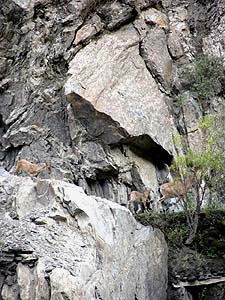 As wildlife has to compete with the ever-increasing numbers of our population for its dwindling resources, it is essential to use the benefits from hunting for both animal habitat and employment for subsistence farms men and herders living within the reserve boundaries. Thus hunting provids a monetary incentive to encourage the local human population to desist from poaching and causing destruction of habitat. With trophy hunting many reserves now see a rise in the population of animals in the game reserves. The communities have now stopped poaching and are protecting the animals and their habitat.
As wildlife has to compete with the ever-increasing numbers of our population for its dwindling resources, it is essential to use the benefits from hunting for both animal habitat and employment for subsistence farms men and herders living within the reserve boundaries. Thus hunting provids a monetary incentive to encourage the local human population to desist from poaching and causing destruction of habitat. With trophy hunting many reserves now see a rise in the population of animals in the game reserves. The communities have now stopped poaching and are protecting the animals and their habitat.
Around 1975 the Wild life department of government of Pakistan along with WWF made extensive surveys of the wild life in Pakistan. It was realized that in the vast and rugged area of our mountains stopping illegal hunting was impossible through enforcement of the law. There was an urgent need to introduce some other policy for saving the endangered animals from extinction. The wildlife department then planned to involve communities for protection of the animal by offering them various incentives. This carried on for a few years before trophy hunting programme was launched in the country in the early 80s with the permission of CITES (Convention on International Trade in Endangered Species of Flora and Fauna). The programme was aimed at the protection of endangered animals through the involvement of communities.
Following wildlife sightings and hunts are available with us. We have our own private properties and homes where we could base you for some of the hunts.
- Markhor Kashmir
- Kabul Markhor
- Markhor Straight Horn
- Urial
- Himalayan Ibex
- Sindh Ibex
- Blue Sheep
KASHMIR MARKHOR, Capra Falconeri
 This endangered goat is now only preserved in its natural habitat in the Chitral region. In appearance they are sturdy animals with strong relatively short thick legs and broad hooves. Both sexes are a reddish gray colour. There is also a crest of long dark hair, extending from the shoulders to the croup with a thick long beard. Found at elevations of up to 3600m it descends to lower heights in winters. This magnificent animal adult measuring at the shoulders (73.5 in ) with massive horns measuring 40 to 50 inches can be photographed during the rut season clashing horns.
This endangered goat is now only preserved in its natural habitat in the Chitral region. In appearance they are sturdy animals with strong relatively short thick legs and broad hooves. Both sexes are a reddish gray colour. There is also a crest of long dark hair, extending from the shoulders to the croup with a thick long beard. Found at elevations of up to 3600m it descends to lower heights in winters. This magnificent animal adult measuring at the shoulders (73.5 in ) with massive horns measuring 40 to 50 inches can be photographed during the rut season clashing horns.
ASTOR MARKHOR Capra falconeri falconeri
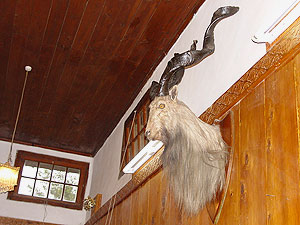 The Astor Markhor is confined to the Gilgit Kargah region besides Chilas Kohistan the upper Kaghan valley and especially on the slopes of the Nanga Parbat Massif. It is also found on both sides of the Astor the upper Indus river along the Rondu and the Haramosh range in Baltistan. In appearance they are sturdy animals with short thick legs with a coat reddish grey in colour the belly and legs creamy white , adult males have a very extensive black beard with a shaggy mane extending down to the chest . Weighing about 240 lbs the males have massive spiral horns measuring around 50 inches plus.
The Astor Markhor is confined to the Gilgit Kargah region besides Chilas Kohistan the upper Kaghan valley and especially on the slopes of the Nanga Parbat Massif. It is also found on both sides of the Astor the upper Indus river along the Rondu and the Haramosh range in Baltistan. In appearance they are sturdy animals with short thick legs with a coat reddish grey in colour the belly and legs creamy white , adult males have a very extensive black beard with a shaggy mane extending down to the chest . Weighing about 240 lbs the males have massive spiral horns measuring around 50 inches plus.
IBEX
 Confined to the arid mountain regions of Chitral , Gilgit and Baltistan they live well above the tree line from about 3500m to 5000m. They are fairly widespread through the higher mountain regions of the Hindu Raj and Hindukush, Ishkuman and the Haramosh range in Biltastan . Probably the highest population of Ibex now survive in the watershed of the Khunjerab in northern Hunza with good trophies in Arkari and Golen region of Chitral in the Hindukush and Hindu Raj. Besti and Golen were private game reserves in our family which still offer the best trophies. The horns of an adult male are large and impressive the record horn length from Gilgit measures 55in. In winters they tend to migrate from one range to another
Confined to the arid mountain regions of Chitral , Gilgit and Baltistan they live well above the tree line from about 3500m to 5000m. They are fairly widespread through the higher mountain regions of the Hindu Raj and Hindukush, Ishkuman and the Haramosh range in Biltastan . Probably the highest population of Ibex now survive in the watershed of the Khunjerab in northern Hunza with good trophies in Arkari and Golen region of Chitral in the Hindukush and Hindu Raj. Besti and Golen were private game reserves in our family which still offer the best trophies. The horns of an adult male are large and impressive the record horn length from Gilgit measures 55in. In winters they tend to migrate from one range to another
BHARAL OR BLUE SHEEP Pseudois nayaur
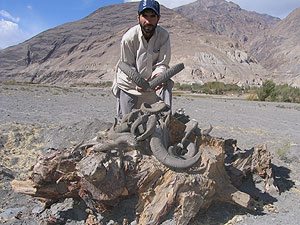 Bharal Blue Sheep are confined to the northern region of the Himalayas and Karakorum between 4500 to 6000m. They live in arid steppe country beyond the monsoon influence. In Shimshal the population has increased considerably around 2000. It is a magnificent sight to see the rams fighting during the rut when they rear up their hind legs before striking sideways with their horns. The Bharal is slightly shorter and more stockily build than the wild sheep Shapu . The adult males have a blue black chest in winters with white legs and belly. The horns are very broad at base and cylindrical, curving outwards almost horizontally bending downwards and backwards at the tip. Horns usually average 24 inch length with basal girth around 13 inches. Males weigh around 180 lbs. Rut season lasts till around November
Bharal Blue Sheep are confined to the northern region of the Himalayas and Karakorum between 4500 to 6000m. They live in arid steppe country beyond the monsoon influence. In Shimshal the population has increased considerably around 2000. It is a magnificent sight to see the rams fighting during the rut when they rear up their hind legs before striking sideways with their horns. The Bharal is slightly shorter and more stockily build than the wild sheep Shapu . The adult males have a blue black chest in winters with white legs and belly. The horns are very broad at base and cylindrical, curving outwards almost horizontally bending downwards and backwards at the tip. Horns usually average 24 inch length with basal girth around 13 inches. Males weigh around 180 lbs. Rut season lasts till around November
URIAL Ovis Vignei
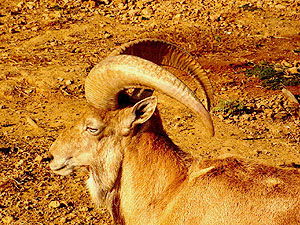 The Punjab Urial also known as Shapu in northern area where it is also found at some points is similar to the Marco Polo sheep in body colouring but smaller in size with shorter less massive horns. It has a greyesh face with long slender legs and the belly is cream white. The horns of mature rams average 30 inch length the record from Zhob Baluchistan being 41.5 inch. These hunts are offered by us in various ranges of the Punjab.
The Punjab Urial also known as Shapu in northern area where it is also found at some points is similar to the Marco Polo sheep in body colouring but smaller in size with shorter less massive horns. It has a greyesh face with long slender legs and the belly is cream white. The horns of mature rams average 30 inch length the record from Zhob Baluchistan being 41.5 inch. These hunts are offered by us in various ranges of the Punjab.